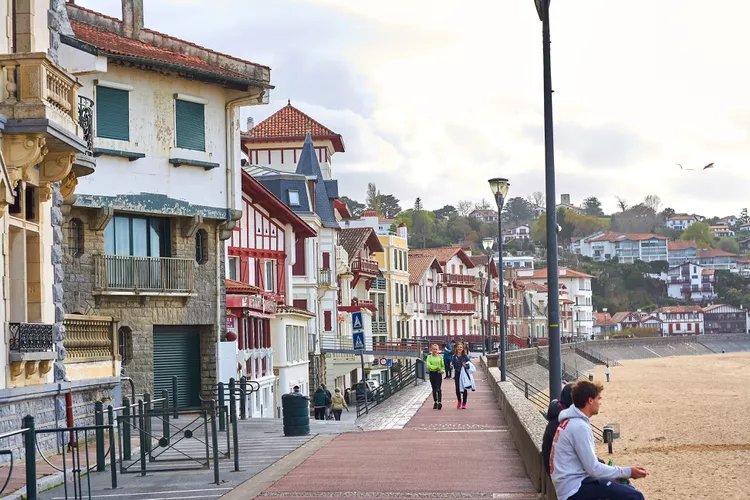Summary
Easily one of the most attractive cities in the Basque Country, from its pretty beaches to its attractive old quarter, Saint-Jean-de-Luz (Donibane Lohizune in Basque) is a jewel in the Basque Country crown. This small beach community is charming, from its port lined with colorful boats to its boutique shops selling surfing gear and lessons year-round. Moreover, due to its balmy climate, it serves as both a winter and summer resort.
Where Is Saint-Jean-de-Luz?
Saint-Jean-de-Luz is located on the French Atlantic coast, the last major town before the border into Spain, just six miles (10 kilometers) away. It sits in the Pyrénées-Atlantique department of France, with Biarritz and Bayonne as its nearest neighbors.
How to Get There
Travelers can take the train or fly to Biarritz. Subsequently, they can catch a train (every 12 minutes) to Saint-Jean station on av de Verdun, which is on the edge of the town center and near the beach.
A Little History
Saint-Jean was a wealthy port involved in Atlantic fishing and whaling (as well as pirates) from the 17th century onwards. Its most illustrious event was the marriage of King Louis XIV, the “Sun King,” to Maria Theresa, the Infanta of Spain on June 9, 1660.
Moreover, the town played a significant role in the ongoing conflicts between France and England when the Duke of Wellington established headquarters there during the Peninsular War of 1813-14.
Saint-Jean was always a strategic port. During World War II, it served as the evacuation point for thousands of soldiers from the Polish Army in France, British nationals, and French fighters who continued to combat Germany after General de Gaulle’s call to persist in the war. In 1940, they were transported to the UK via passenger ships bound for Liverpool.
What to See
Saint-Jean-de-Luz stands in a beautiful and protected sandy bay with excellent beaches, making it ideal for families. Surfers can venture to Biarritz for its powerful Atlantic waves, a significant attraction for athletic enthusiasts.
Saint-Jean-de-Luz’s success as a fishing port was due to its ideal location. The long stretch southwards from the Bay of Arcachon near Bordeaux features some of the best surfing in France, benefiting from exposure to the Atlantic’s great breakers. However, Saint-Jean is sheltered by being on an estuary between two headlands, complemented by significant dikes and the Artha breakwaters. This setting offers stunning views from the quays across the harbor to the old town.
The Old Town
Visitors can explore the streets and discover delightful half-timbered mansions built by the wealthy shipowners and merchants of the town. Notable sites include the Maison de L’Infante (Quai de l’Infante), an imposing 4-story redbrick and stone structure that once belonged to the affluent Haraneder family. The infanta stayed here with her future mother-in-law, Anne of Austria, prior to their wedding. Today, this historic building reveals a large 17th-century room adorned with a ceiling painted in the Fontainebleau style and a grand fireplace, making it quite impressive.
The French king also resided at the Maison Louis XIV (6 place Louis XIV), built in 1635 and noteworthy for its historical significance. Inside, visitors can see various rooms, including the magnificent bedchamber where state matters were conducted, as well as the kitchen.
The church of St-Jean-Baptiste, located on the main shopping and tourist street (rue Gambetta), is another essential site. Dating from the 15th century, this church is the largest and most famous Basque church in France. Although it appears plain from the outside, the interior reveals a grand space with a vaulted roof of painted panels. The church also features three tiers of dark oak galleries, reserved for men, with women seated on the ground level. Highlights include a gold altarpiece from the 1670s and a 17th-century pulpit, as well as a bricked-up doorway once used by the royal pair, now sealed forever.
Year-Round Surfing
Saint-Jean-de-Luz offers year-round surfing opportunities. Families can enjoy the secure environment of the Grande Plage beach in town, where lifeguards are present from June to mid-September. Sunbeds and windbreaks are available for rental. Furthermore, lifeguards are on duty daily from 11 a.m. during the summer season, and on weekends in May.
If you’re seeking surfing hotspots, venture outside the town to the beaches of Plage d’Erromardie, Plage de Mayarco, Plage de Lafiténia, and Plage de Cénitz, all renowned for excellent surfing conditions.
With its excellent surfing reputation, the area boasts numerous surf shops where visitors can purchase or rent equipment and arrange lessons, from one-off classes to week-long immersive experiences.
Where to Stay and Eat
- Les Goëlands (4-6 av d’Etcheverry) is situated in two charming turn-of-the-century villas near the beach and old town. Opt for a room with a balcony and sea view, and enjoy the restaurant, garden, and free parking.
- Le Petit Trianon (56 bd Victor-Hugo) is a delightful hotel near the beach featuring brightly decorated rooms and excellent bathrooms. Guests can enjoy buffet breakfast on the terrace during the summer.
- The smart 3-star Hotel de la Plage (Promenade Jacques Thibaud) offers balconies with beautiful sea views and lower-cost rooms overlooking the town. The hotel ensures comfort and attentive service, which includes a well-regarded restaurant, La Brouillarta, where diners can indulge in good food while potentially witnessing stunning ocean views.
- Zoko Moko (6 rue Mazarin) boasts stone walls and pristine white tables, making it a perfect backdrop for exceptional cuisine. While slightly more expensive, its focus on top-notch seafood and fresh ingredients justifies the cost.
Thalassotherapy
Saint-Jean-de-Luz offers a wonderful escape for those looking to experience sea-based spa therapies and indulge in thermal spa waters. Visitors can engage in a variety of services, from underwater hydro massage to aqua gym classes. The two main spas and health resorts to explore are Loreamar Thalasso Spa and Thalazur Thalasso Spa.
The Tourist Office is conveniently located opposite the fish market at the corner of bd Victor Hugo and rue Bernard Jaureguiberry.
Edited by Mary Anne Evans




